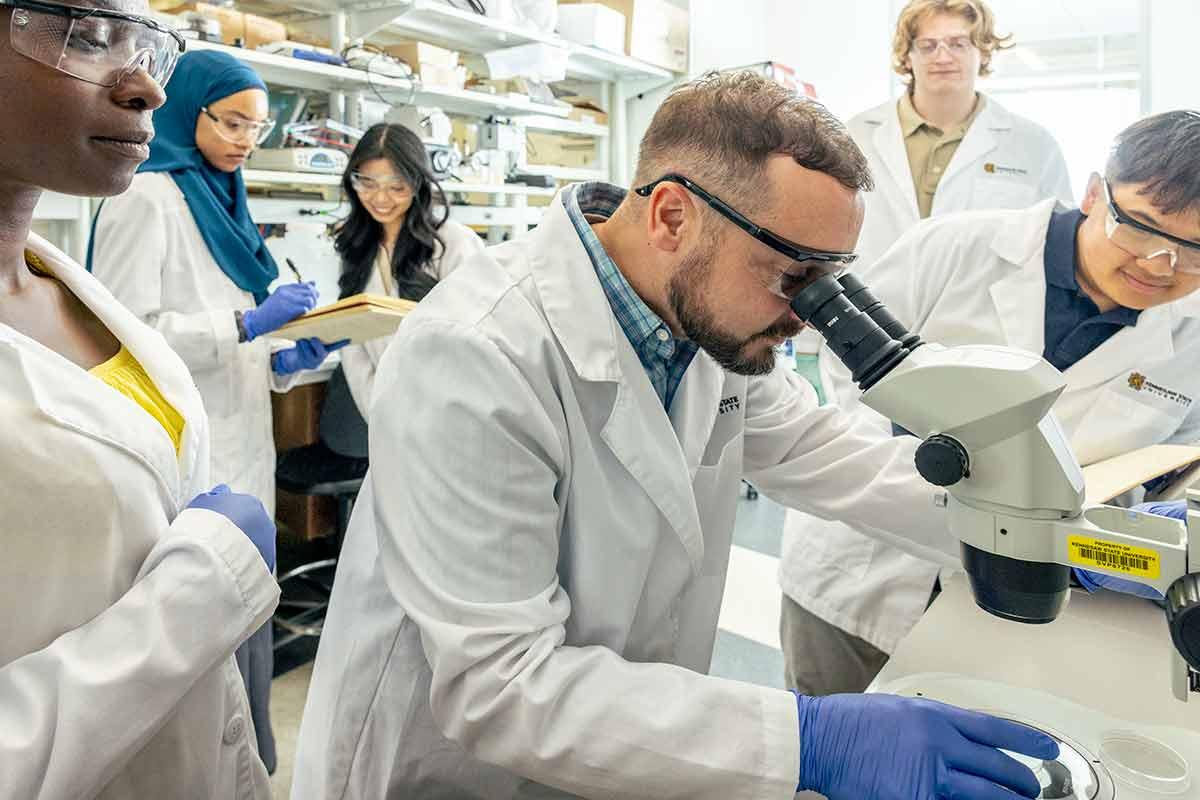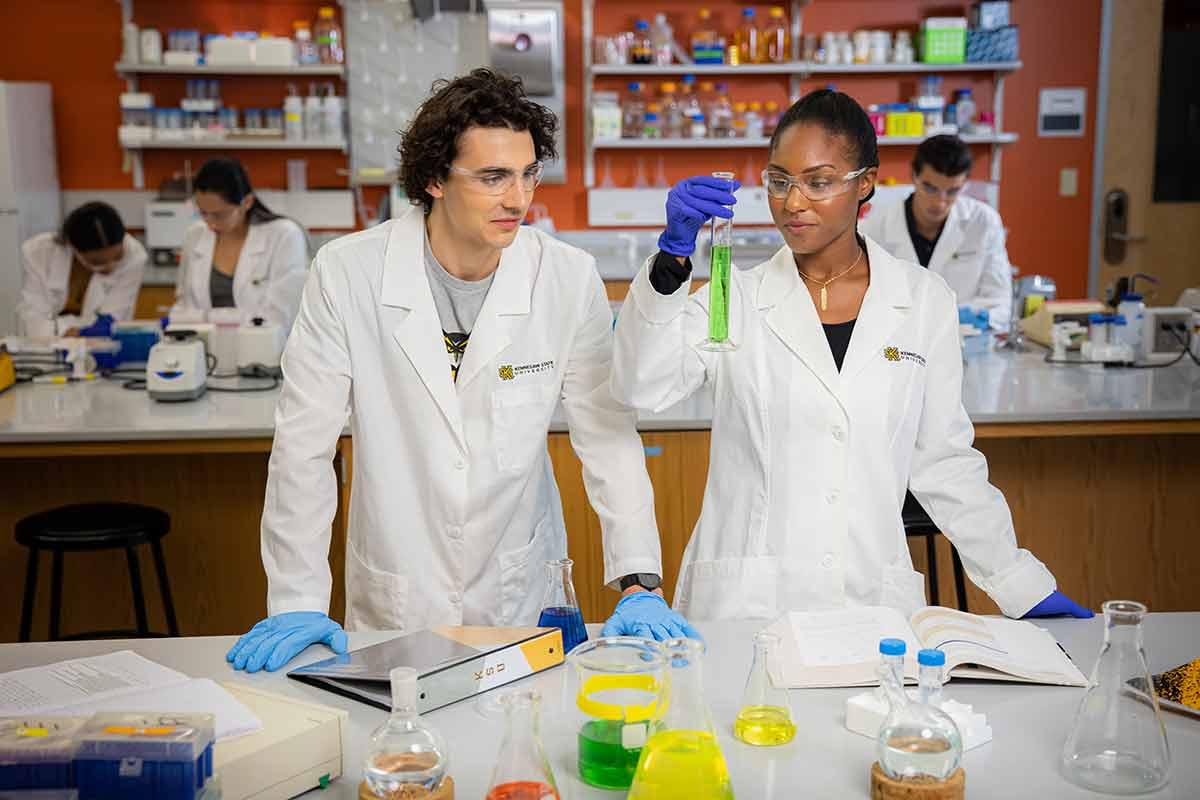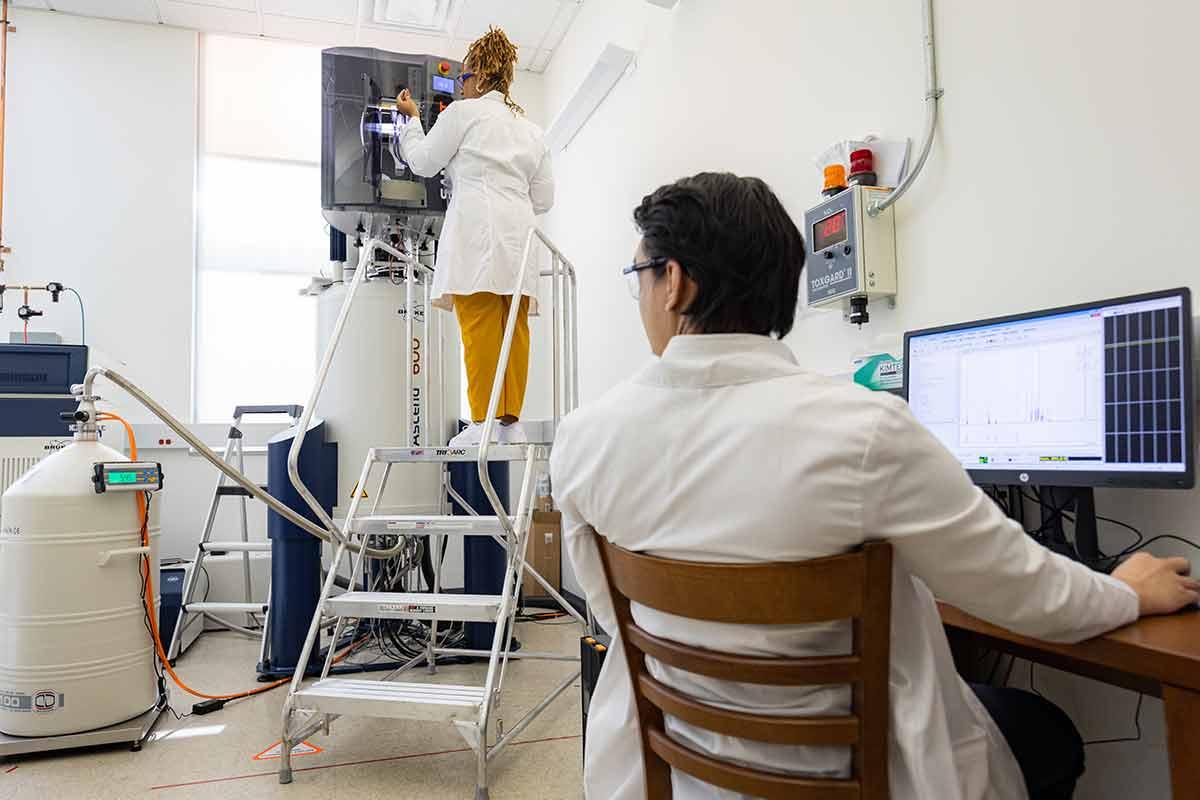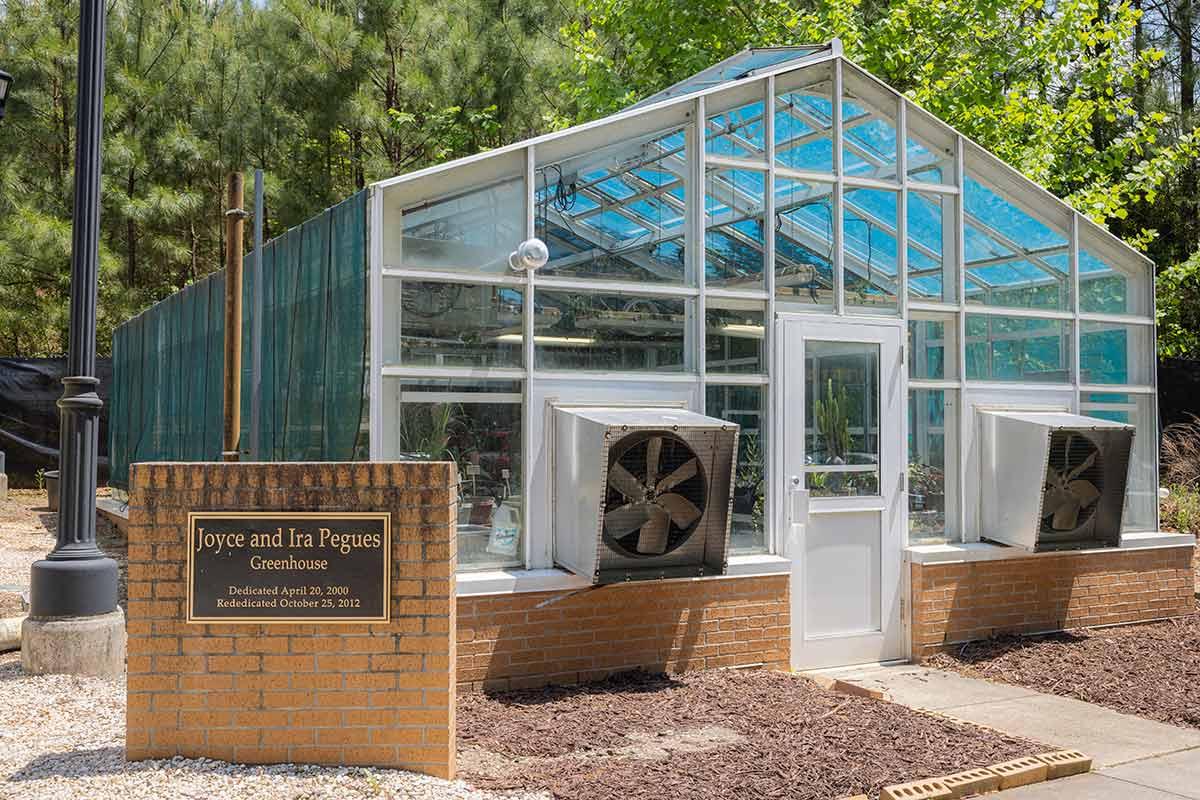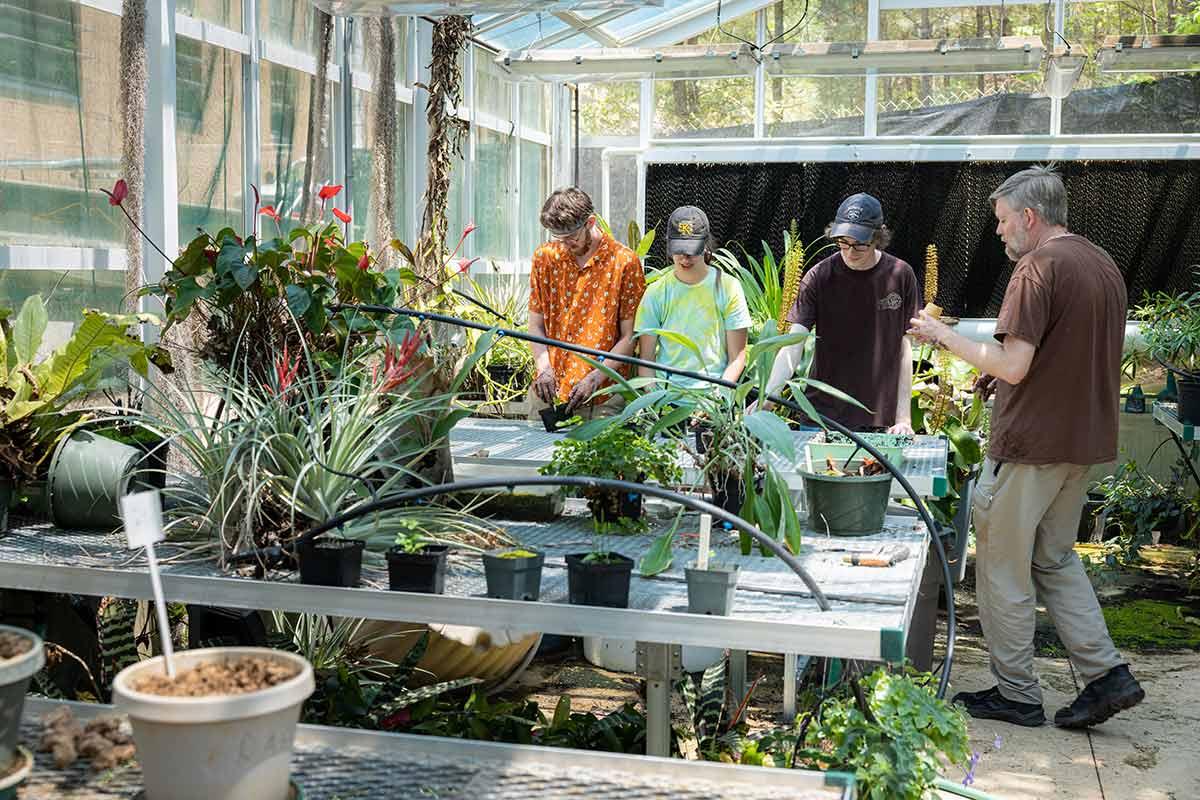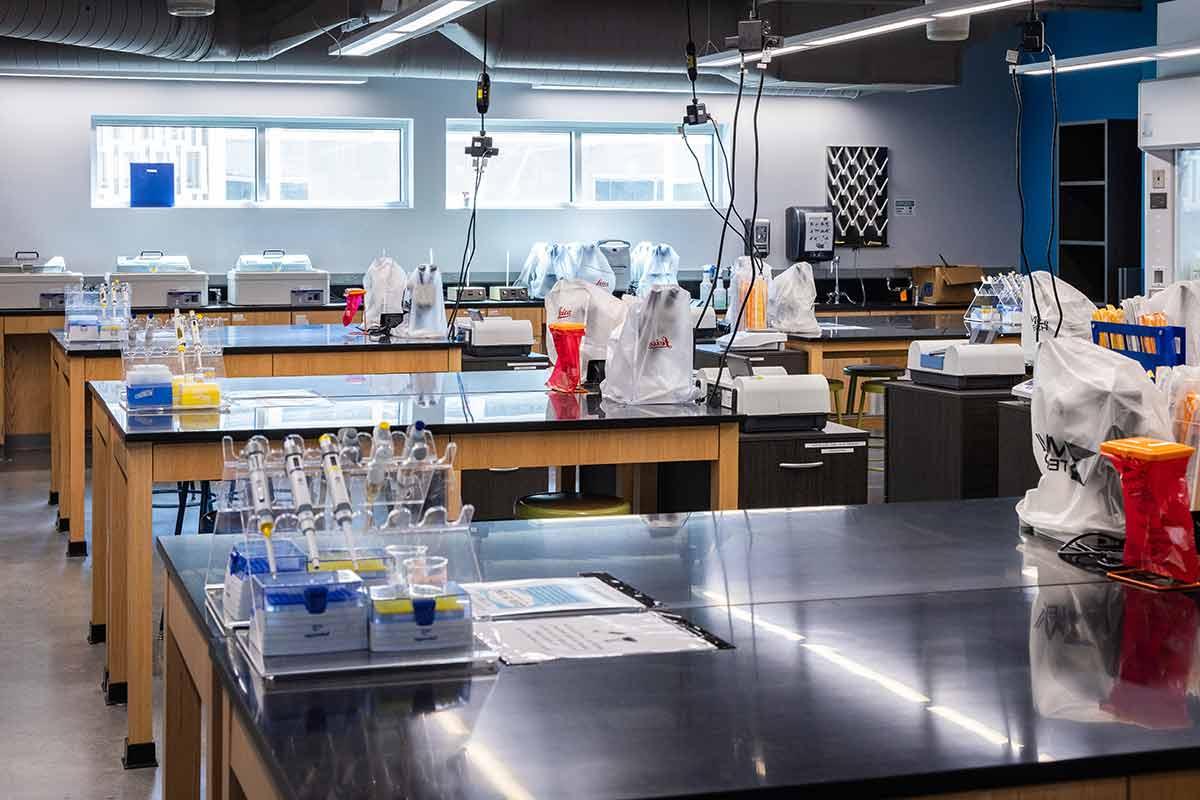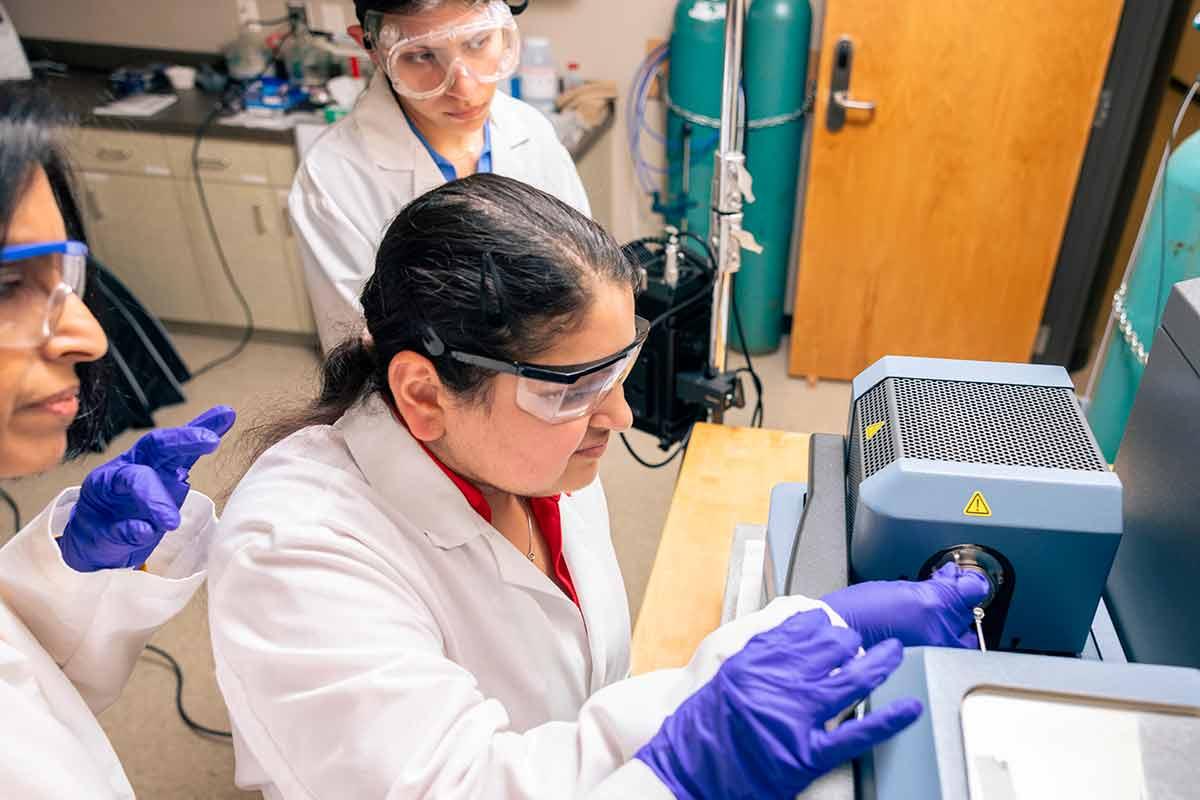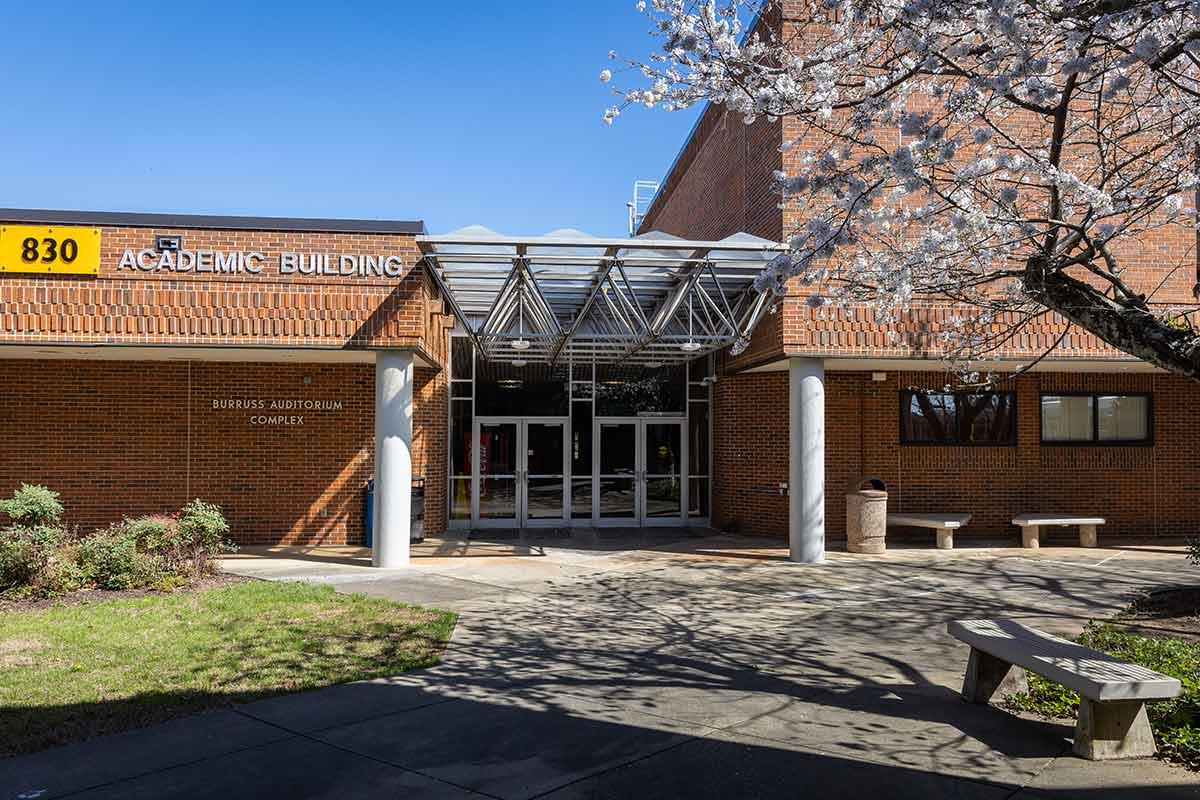
Research in the College of Science and Mathematics
Research in the College of Science and Mathematics (CSM) at Kennesaw State University (KSU) is a large part of graduate, as well as undergraduate student's studies at this student-centered, research-driven R2 institution.
CSM is pleased to offer a number of significant internal research funding opportunities for faculty, support creative activity and scholarship of faculty, and provide undergraduate students with research and creative experiences to enhance their learning.
Department Research Areas
The research areas at the College of Science and Mathematics allows students to expand their skills beyond their major in various interdisciplinary fields that span across the departments. Students will have the exciting opportunity to engage with dedicated and knowledgeable faculty members to conduct research that helps grow and support our surrounding communities. Each department offers subcategories that fit into the interests within each field for every student to excel in research that matters most to them.
Select a department below to learn more about the research possibilities and subcatergories available:

Research Interest Groups
Research Interest Groups (RIGs) help connect PIs across campus to build interdisciplinary teams that span multiple colleges, schools, or units, but for which there is not an established unit on campus. Topics, research questions, and goals are all driven by members of the RIGs. RIGs are a great way to mobilize a team with shared or complementary expertise and goals.
The College of Science and Mathematics (CSM) offers collaborative research opportunities in the following interest areas. Click on the research interest groups for more information, as well as the faculty associated.
- Adaptation and Change in the Environment
- Biomolecule Structure and Functions
- Chemical Biology and Drug Discovery in Microorganisms
- Cell, Developmental and Organismal Physiology
- Diseases in humans and model systems
- Materials Science
- Modeling of Physical and Biological Systems
- Microorganisms Biology and Infection
- Photonics and Applications
- Research in Undergraduate Science and Mathematics Education
- Theoretical Particle Physics

Core Facilities
CSM Core Facilities provide state-of-the-art equipment and services to researchers at KSU, other universities, government agencies, nonprofit organizations and industry. These facilities make use of highly specialized scientific equipment, diagnostic tools, adaptable prototyping processes and mechanical production shops.
Featured Labs
Other Equipment
The College of Science and Mathematics at Kennesaw State University (KSU) helps students, faculty, and external researchers by providing modern equipment, training, and assistance for advancing their projects across various research area. Listed below are some of the specialty equipment items used to make Kennesaw State a leader in research nationally and throughout the Southeast.
-
Agilent Cary 5000 UV-Vis-NIR Spectrometer
Agilent Cary 5000 UV-Vis-NIR Spectrometer is a high-performance UV-Vis-NIR spectrophotometer with excellent photometric performance in the 175-3300 nm range. The Cary 5000 features a PbSmart detector with an extended NIR range to 3300 nm, making it a powerful tool for materials science research.
Uncover the power of the Agilent Cary 5000, a state-of-the-art UV-Vis-NIR spectrophotometer delivering exceptional sensitivity, accuracy, and versatility for a broad range of research applications in materials science, life sciences, and beyond.
-
Anton Paar Multiwave GO Plus Microwave digestion System
Microwave digestion offers a faster and more complete digestion of solid materials for total elemental analysis when compared with a more traditional hot-block system, completely digesting samples in hours instead of days. Microwave digestion breaks down solid materials using concentrated acid at temperatures of up to 200°C. Heavy teflon digestion vessels are designed to withstand the extreme pressure created by heating acids to these temperatures and utilize a venting system to ensure that the pressure inside the vessels is stable throughout the digestion. The Multiwave GO Plus can digest 12 samples of up to 1g each at one time, allowing for good throughput of samples. Once digested, samples can be analyzed for the concentration of any elements of interest using the College of Science and Math's Perkin Elmer Avio 200 ICP-OES system. Please note that samples containing HF cannot be analyzed using the ICP system as HF can damage the ICP's nebulizer. -
ASAP 2020 PLUS
The ASAP 2020 Plus is a high-performance adsorption analyzer for measuring surface area, pore size, and pore volume of powders and porous materials. Standard methods or user customized protocols can be used to characterize adsorbents, catalysts, zeolites, MOFs, APIs, excipients, and a wide variety of porous and non-porous materials. The ASAP 2020 Plus is ideally suited for gas adsorption analysis of microporous (0.35 to 2nm) and mesoporous (2 to 50nm) materials and delivers superior accuracy, resolution and data reduction. A vapor sorption option can be added to the ASAP 2020 Plus to extend the analysis range of the ASAP 2020 Plus physisorption.
A chemisorption option extends the application range of the ASAP 2020 plus to both physical and chemical adsorption for characterizing the texture and active surface of catalysts, catalyst supports, sensors and a variety of other materials.
-
BD Acurri C6 Flow Cytometer
The Accuri C6 flow cytometer is equipped with 488nm and 647nm lasers, and four fluorescence detectors that can arranged in different modes via the use of interchangeable filters. Particle size and granularity are measured using forward and side-scatter detectors. The system is powered by BD software, and data can be exported in multiple file formats, including FCS-3 standard. The instrument is very easy to set up and run, and utilizes distilled water as the sheath fluid.
Please contact Martin Hudson for training and scheduling. This instrument was purchased via a donation from the Georgia Research Alliance.
-
BiacoreX100 SPR Biosensor
Our workhorse Biacore X100 SPR Biosensor facilitates kinetic and affinity analysis for intermolecular interactions using the established surface plasmon resonance (SPR) technology. National Science Foundation )NSF) logo The instrument is useful for a wide range of biological molecules and conditions, e.g. temperature control down to 4° C. Its sensitivity allows for analysis of small molecules down to 100 Da.
Partially funded by NSF. For all inquiries, contact: Jonathan McMurry.
-
BiologGEN III Microstation System
The BiologGEN III MicroStation System rapidly and accurately identifies about 3,000 species of aerobic and anaerobic Bacteria, Yeasts, and Fungi. The systems phenotypic technology provides valuable information on the properties of strains, in addition to a species-level identification. The systems technology identifies environmental and pathogenic microorganisms by producing a characteristic pattern, or “metabolic fingerprint”, from individual test reactions performed within a 96 well microplate. Culture suspensions are tested with a panel of pre-selected assays, then incubated, read, and compared to available databases. -
D8 VENTURE
SINGLE CRYSTAL X-RAY DIFFRACTION (SC-XRD) D8 VENTURE
Strongest X-ray sources
Highest performing X-ray detectorsThe D8 VENTURE provides a more spacious enclosure for your experiment with more room for rotating anode, liquid metal jet and dual wavelengths solutions. All systems feature the revolutionary PHOTON III photon-counting detector. The D8 VENTURE offers highest experimental flexibility, with excellent sample accessibility and visibility. It is engineered with high modularity from best-in-class components and is available in popular all-air-cooled configurations. Easy upgradeability protects your investment with maximum flexibility for future extensions.
-
Eppendorf BioFlo 320 and BioFlo 120 Bioprocess Control Systems
Whether your process includes cell culture or fermentation, with bacteria, yeasts, fungi, mammalian, insect or plant cells, and including compatibility with autoclavable or single-use bioreactors from 250 mL to 40 L, the BioFlo 120 and 320 systems seamlessly combines form and function in one state of the art package. These bioreactors run independently with the 120 supporting microbial fermentation and the 320 having additional cell culture capabilities. Currently, CSM has 500mL, 1L, and 5L autoclavable bioreactor vessels. The gas supply includes air and O2. Additional configurations are available at the user’s request. -
ForteBio Octet Red96e Biosensor
Using biolayer interferometry (BLI), the ForteBio Octet Red96e Biosensor allows for rapid, real-time, label-free kinetic analysis of binding between biomacromolecules. By analyzing the shift in the interference pattern of white light that results from one molecule binding another on disposable sensors, we can easily assign rate and affinity constants. Kennesaw State is a leading publisher of BLI data.
Funded jointly by the National Institutes of Health (NIH) and the College of Science and Mathematics at Kennesaw State University. For all inquiries, contact: Jonathan McMurry.
-
Glass Research Laboratory
The Glass Research Laboratory consists of two laboratory spaces housed under the physics department at the Marietta campus:
- High-Temperature Furnace Laboratory: The furnace lab is in building G. The laboratory is equipped with Sentro-Tech ST-1600, and Thermo-Scientific Muffle-furnace, Mixer Mill MM 500, and an advanced digital glass cutter with diamond blades. The lab is equipped with a fume hood, storage cabinets, chemical storage, sink, eyewash, and shower. The sink, eyewash, and the shower are built with handicap access.
- Thermal Laboratory: This research laboratory is used for thermal analysis and X-Ray Diffraction studies. This lab is equipped with wall cabinets as well as countertop space with cabinets. The SDT Q600 Thermal Analyzer is housed in this lab and is on a special vibration-free table. The 554 800 RONTGENGERAT X-Ray apparatus is housed in this laboratory along with an optical microscope and a high precision scale. This laboratory is equipped with large N2, Ar, and dry air gas cylinders.
For all inquiries, contact: Kisa Ranasinghe.
-
JEM-1400 series 120kV Transmission Electron Microscope (TEM)
The JEOL JEM-1400 series 120kV Transmission Electron Microscope (TEM) is widely accepted for its ease of use and high resolution imaging and analysis. Applications include pathology, biology, quality control, nanotechnology, polymer, and materials development.
Introduced in 2017 and derived from the highly successful JEM-1400(Plus), the JEM-1400Flash makes it easier for the user to first view samples at low magnification before studying the fine structures of interest at high magnification. To smoothly transition from low to high magnification and acquire higher-throughput image data, the JEM-1400Flash has an integrated high-sensitivity sCMOS camera, an ultra-wide area montage system, and an OM (optical microscope) image linkage function. To increase the throughput, the JEM-1400Flash is equipped with a TMP, which besides resulting in an oil-free column vacuum, also allows for instantaneous sample exchanges.
-
PerkinElmer Ave 200 Inductively Coupled Plasma Optical Emission Spectrometer
The PerkinElmer Avio 200 Inductively Coupled Plasma Optical Emissions Spectrometer (ICP-OES) is a powerful instrument capable of analyzing aqueous samples for approximately 95% of the elements on the periodic table. For most elements, the ICP can resolve concentrations down to the parts per billion level and for certain elements it can resolve concentrations as low as tens of parts per trillion. The instrument features an autosampler that can be programmed to analyze several dozen samples once a programmed run is started.
All inquiries should be directed to Dan Ferreira.
-
Rigaku MiniFlex
BENCHTOP XRD: MINIFLEX
X-Ray Diffractometers that guide you through measurements.
Rigaku MiniFlex powered by SmartLab Studio II software is a multi-purpose benchtop XRD with a proven record:
- Improved through six generations since its introduction in 1973 as the first commercial benchtop XRD
- Covers all powder and bulk diffraction analysis needs from phase identification, quantitative analysis, polymorphs analysis, and Rietveld refinement.
- More than 40,000 papers published by MiniFlex users
-
Renishaw InVia confocal Raman spectrometer
Designed, developed and refined over more than two decades to make it the most trusted Raman instrument on the market. The Renishaw inVia™ confocal Raman spectrometer is the ultimate research-grade microscope for your current and future needs.
It is simple to operate yet delivers outstanding performance and reliable results, for even the most challenging experiments. You can produce both rich, detailed, chemical images and highly specific data from discrete points. With unparalleled flexibility, scientists and engineers, worldwide, trust the inVia microscope.
-
Sony Biosciences SH8oo Cell Sorter
The SH800 cell sorter is equipped with four lasers (405nm, 488nm, 561nm and 638nm) and six fluorescence detectors in addition to forward and backscatter detectors. This laser setup permits maximum flexibility in experimental design and allows easy discrimination between live cell labels such as GFP and RFP or Cherry. Disposable sorting chips featuring microfluidic technology are used to combine the sheath and sample lines. Fluidics, laser alignment, and sort stream calibration are all fully automated. The system can be run in analytical and preparative sort modes. Multiple sample tubes can be accommodated (0.5ml microfuge tube up to a 35ml centrifuge tube) and a wide variety of collection systems are available for cell sorting runs, including a 96 well-format collector that can be used in single cell sort mode. The entire instrument is housed in a custom-built Baker BSL class IIA biosafety cabinet, allowing the safe sorting of potentially hazardous samples. The system is controlled by proprietary Sony software and is very easy to set up and use.
Please contact Martin Hudson for training and scheduling. This instrument was purchased via a NSF MRI grant.
-
TGA 8000™ Thermogravimetric analyzer
TGA 8000™ Thermogravimetric analyzer gives you complete control over your sample environment and delivers high throughput and reliability, even unattended. Plus, advanced hyphenation technology works beautifully with FT-IR, MS, GC/MS, and other systems for better understanding of evolved gases.
CSM Research Support and Opportunities
The College of Science and Mathematics (CSM) is committed to research and the success of our faculty and students. We strive to present the many university-wide and college-wide support and opportunities available to you as you plan your research career. Whether you are faculty, students or community and industry partners exploring collaborative research ideas, or prospective students and faculty considering research in CSM, we welcome you to explore our research support, partnerships, and educational opportunities.
-
Undergraduate Research Programs
- Birla Carbon Scholars Program - Birla Carbon has generously partnered with the College of Science and Mathematics (CSM) at Kennesaw State University for more than ten years to present the Birla Carbon Scholars Program and Symposium. Since the original program kicked off in 2014, the Birla Carbon Scholars Program gives CSM students financial support to expand their research skills in a summer research program.
- Inspire Summer Scholars Research Program - The goal of this summer program is to provide experiential learning to undergraduate science and mathematics majors. Students will develop skills to enhance their interest in undergraduate research, service learning, and internships.
-
Graduate Research Programs
- Peach State Bridges to the Doctorate - This National Institutes of Health (NIH) T32 training grant is part of a federal program that aims to develop an enriched pool of well-trained biomedical scientists who will transition from master’s degree programs and complete rigorous biomedical, research-focused doctoral degree programs in biomedical fields.
-
KSU Resources for Research
- KSU Office of Research
- Digital Commons - Digital Commons at KSU, as an institutional repository (IR), bringing together all of the University's research under one umbrella, with an aim to preserve and provide access to that research.
- The Kennesaw Journal of Undergraduate Research - The Kennesaw Journal of Undergraduate Research (KJUR) is a peer-reviewed scholarly journal dedicated to promoting academic study and achievement among undergraduate students at Kennesaw State University.
-
CSM Graduate Programs
- Master of Science in Chemical Sciences (MSCB) - Chemical Sciences graduate degree is a thesis-based program with tracks in chemistry and biochemistry, designed for you to complete your coursework and thesis research within two academic years.
- Master of Science in Integrative Biology (MSIB) - MSIB is a research-based program with a curriculum that provides integrative courses and experiences designed to foster connections across the life sciences spectrum.
- The Graduate College at KSU











